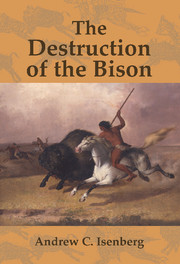5 - The Wild and the Tamed
Published online by Cambridge University Press: 05 August 2012
Summary
As the Civil War approached its end, the citizens of the United States faced the prospect of an Indian war in the Great Plains. John Evans, the governor of the Colorado Territory, predicted in 1864 that the coming hostilities “will be the largest Indian war this country ever had, extending from Texas to the British line involving nearly all the wild tribes of the plains.” Contention over the control of natural resources was the root cause of the brewing conflict. In the southern plains, the nomads struggled to preserve their stewardship of the bison herds, while Euroamericans sought access to ranchlands and the gold mines of Colorado. For the southern plains nomads, the conflict reached its nadir on November 29, 1864, when Colonel John Chivington led two companies of Colorado volunteer cavalry in an attack on noncombatant Southern Cheyennes at Sand Creek. Chivington and his men killed one hundred fifty Cheyennes; two-thirds of the dead were women and children. The Commissioner of Indian Affairs and a Congressional committee rebuked those involved in the massacre, but Chivington won broad support among Euroamericans in Colorado, including Governor Evans.
In the northern plains, the conflict between Indians and Euroamericans over the control of natural resources also raged. The dispute of the northern plains nomads with the United States centered on the Bozeman Trail leading from Fort Laramie to the gold mines of Montana.
- Type
- Chapter
- Information
- The Destruction of the BisonAn Environmental History, 1750–1920, pp. 123 - 163Publisher: Cambridge University PressPrint publication year: 2000

